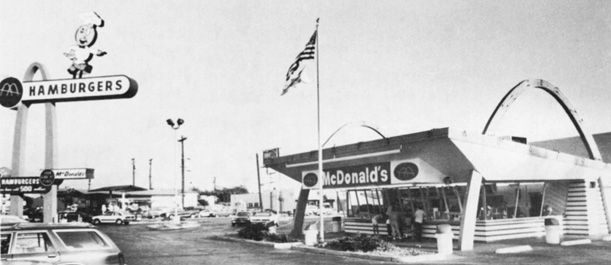The second McDonald’s ever built and the oldest still standing, in Downey, CA. (image: Alan Hess via Journal of the Society of Architectural Historians)
When the ancient Romans marched through arches, it was a celebration of victory, an end to long-fought battles and distant travels. Today, when we march through arches, it is a celebration of globalization, efficiency and Shamrock Shakes. Long before McDonald’s golden arches stood for the triumph of globalization, they stood for the triumph of a hamburger stand and the impact of the automobile on American culture and architecture. In a 1986 article for the Journal of the Society of Architectural Historians, architect Alan Hess explains the origins of McDonald’s famous arches.
Hess writes that in the early 1950s brothers Richard and Maurice McDonald hired architect Stanley Clark Meston to design a drive-in hamburger stand that carried on the traditions of roadside architecture established in the 1920s and 1930s. The brothers McDonald had some experience with previous restaurants and a very clear idea of how they wanted their new venture to work – at least on the inside. Meston described the design as “logically dictated by clear program and commercial necessities” and compared it to designing a factory. Though he didn’t necessarily consider himself a modernist, Meston’s pragmatic, functionalist approach reveals, at the very least, a sympathy with some of the tenets of Modernism. Function before form. But not, it would appear, at the expense of form.
And anyway, the exterior had its own function to fulfill. In an age before ubiquitous mass media advertisements, the building was the advertisement. To ensure the restaurant stood out from the crowd, Meston decided to make the entire building a sign specifically designed to attract customers from the road. Now, many architects have speculated that McDonald’s iconic Golden arches have their origin in Eero Saarinen’s 1948 design for the St. Louis Gateway Arch or Swiss architect Le Corbusier’s unbuilt 1931 design for the Palace of the Soviets. But they tend to read little too much into things. The answer is much simpler.
